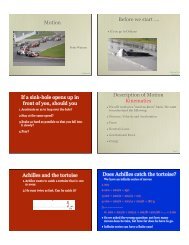Energy Introduction
Energy Introduction
Energy Introduction
Create successful ePaper yourself
Turn your PDF publications into a flip-book with our unique Google optimized e-Paper software.
<strong>Energy</strong><br />
<strong>Energy</strong><br />
• an incredibly powerful idea, which governs<br />
the behaviour of<br />
• cars<br />
• humans<br />
• cell-phones<br />
• atoms<br />
• weather<br />
• galaxies .......<br />
Potential <strong>Energy</strong><br />
Boris23<br />
Wikipedia<br />
• If you drop something, kinetic energy increases.<br />
• This energy is originally in the form of potential<br />
energy (P.E.).<br />
Text<br />
• Near the earth’s surface if you lift a body of mass m<br />
through a height h, its change in PE is<br />
• P.E. = mgh<br />
Text<br />
How does a roller-coaster work?<br />
Start with the energy of motion<br />
Kinetic energy<br />
• is defined to be<br />
• K.E. = 1 /2mv 2<br />
Note it doesn’t matter how<br />
we get the energy<br />
• e.g putting a block on a table can be done in<br />
many ways, but the energy is always the same<br />
Text
• Need a unit for energy: the Joule (Joule<br />
originated study of heat energy ⇔<br />
mechanical energy)<br />
• so a 1500 kg car travelling at 10 m/s has a KE<br />
of 75000 J<br />
• computer dropped from 1 metre ~ 1J<br />
Conservation of <strong>Energy</strong><br />
(nothing to do with energy<br />
conservation!)<br />
• <strong>Energy</strong> can be transformed from one kind to<br />
another, but cannot be created or destroyed<br />
• As long as there is no friction total<br />
(mechanical) energy will be conserved: it can<br />
be transformed from one form to another.<br />
• P.E. ⇔ K.E.<br />
• Doesn’t matter how complicated the force is<br />
Text<br />
Most systems dissipate energy<br />
• But actually it just gets converted to heat<br />
energy<br />
Text<br />
Wikipedia<br />
Some conversions<br />
• kilo: 1kJ = 1000 J<br />
• mega: 1MJ = 10 6 J=1000000 J<br />
• giga: 1GJ = 10 9 J=1000000000 J<br />
• tera: 1TJ = 10 12 J=1000000000000 J<br />
• peta: 1PJJ = 10 15 J=1000000000000000 J<br />
• eka: 1EJ = 10 18 J=1000000000000000000 J<br />
Note that the force can be incredibly complicated<br />
Heat energy<br />
e.g boiling one litre of water takes ~ 2.3 MJ (million joules)<br />
James Prescott Joule<br />
Joule was the first person to figure<br />
that heat was a form of energy<br />
Text<br />
PW<br />
Text
But we could get<br />
the energy from<br />
somewhere else.......<br />
e.g. Chemical<br />
energy<br />
• Burning 1 Litre of gasoline<br />
~35 MJ (35000000 J)<br />
• Hydrogen bomb: heat small amount of gas<br />
up to ~10 billion °C for a very short time<br />
• ~1 PJ<br />
Nuclear <strong>Energy</strong><br />
• 100 trillion Joules<br />
Text<br />
How much energy does Canada use?<br />
• 1 EJ = 10 18 J/year<br />
Text<br />
Text<br />
Electrical <strong>Energy</strong><br />
• Lightning bolt has<br />
about 5 GJ<br />
• 5 billion joules<br />
Text<br />
Bio-chemical energies<br />
• Your daily consumption (as food)~10MJ<br />
•Where does it come from?<br />
Vermeer<br />
Where does it go?
Gravity again<br />
• Since the force gets weaker as we move away<br />
from earth, expect P.E. to get smaller<br />
• near Earth’s surface<br />
•P.E. = mgh<br />
• anywhere:<br />
• P.E. = − GM earth m<br />
• To get to moon, must escape the "gravity<br />
well" of the earth and fall into that of moon<br />
r<br />
Total energy never changes<br />
• At an infinite distance from the earth,<br />
spaceship has stopped moving<br />
• K.E. is zero<br />
• P.E. is zero<br />
K.E +P.E. = 0 + 0<br />
= 1<br />
2 mv2 − GM earth m<br />
R earth<br />
Text<br />
• What are these?<br />
•<br />
Constant = 6.67×10 -11<br />
Mass of Earth = 6×10 24kg<br />
P.E. = − GM earth m<br />
r<br />
Mass of whatever<br />
we are looking at<br />
Distance from the<br />
centre of the earth<br />
• At the earth’s surface, we want some K.E +<br />
some P.E.<br />
•<br />
How fast do we need to<br />
throw something to escape<br />
from the earth’s gravity?<br />
Total energy. = P.E.+ K.E.<br />
= 1<br />
2 mv2 − GM earthm<br />
r<br />
v escape = 2GM earth<br />
R earth<br />
• e.g. for the earth:<br />
• R = 6500 km = 6.5 x10 6 m<br />
• G = 6.67x10 -11<br />
• M= 6x10 24 kg<br />
• then<br />
• vescape~11100 m/s ~ 11 km/s<br />
• vorbit~7 km/s (close to earth’s surface)<br />
•<br />
Text
• Means there is a minimum energy we must<br />
have to escape earth:<br />
• e.g. for 1kg need at least 60 megajoules<br />
(roughly 3 litres of gas)<br />
• but the 3 litres of gas weighs more than a<br />
kilogram ......<br />
Black Holes<br />
• Invented by .....?<br />
• Einstein<br />
• Hawking?<br />
• Well, actually, John Michell, rector of Thornhill<br />
Church in Yorkshire<br />
• geologist?philosopher? astronomer? Seismologist?<br />
• Polymath.<br />
• presented his ideas to the Royal Society in London in<br />
1783.<br />
•A particle will escape from the earth if it has<br />
positive energy<br />
• At the earth's surface, v~ 11 km/s<br />
• However we can interpret this differently:<br />
what radius would the earth have for a given<br />
escape velocity? In particular, if the escape<br />
velocity is the speed of light c, nothing can<br />
escape<br />
Text<br />
Text<br />
This has been done with rockets<br />
• How fast can a rocket<br />
go?<br />
• Depends on exhaust<br />
speed.<br />
• Suppose we have<br />
rocket with a mass of<br />
100 tonnes, final mass<br />
10 tonne, exhaust vel<br />
= 3000 m/s, final vel<br />
will be ~6000 m/s<br />
• In practice need<br />
multi-stage rocket<br />
• A particle will<br />
escape from the<br />
earth if it has<br />
positive energy<br />
• At the earth's<br />
surface, “escape<br />
velocity” is 11 km/<br />
s<br />
Black Holes<br />
• This is the Schwarzchild radius (loosely the<br />
black-hole radius) for any mass.<br />
• What is this for the earth?<br />
• ~ 9 mm<br />
• Statutory Warning:This is a fudge: you cannot<br />
treat light as a massive particle, nor can you<br />
handle a very strong gravitational field as if it<br />
were a weak one......<br />
(there are actually two factors of 2 error which<br />
cancel out.....weren't we lucky!)<br />
Text<br />
Text
•If the earth was 9 mm in radius, it would be a<br />
Black hole<br />
•This is the Schwarzchild radius: roughly the black<br />
hole radius<br />
James Watt<br />
Peter Watson<br />
• Beam engine was<br />
first efficient steam<br />
engine<br />
• enabled the<br />
industrial revolution<br />
One more related idea:<br />
Momentum<br />
• Stopping a tennis ball is easy<br />
• Stopping a medicine ball isn’t easy<br />
Wikipedia<br />
<strong>Energy</strong> ≠ Power<br />
(but they are related)<br />
• Power = rate of energy consumption (or rate<br />
of energy production)<br />
• 1 watt = 1 Joule/second<br />
• Light-bulb ~100W<br />
• You (from food) ~ 100 W<br />
• Laptop~50 W<br />
• Car (at 60 km/hr) ~ 40 kW<br />
• From sun: 1.4 kW/m 2<br />
• Total ~300 GW<br />
• Electrical ~60GW<br />
• per capita ~ 10 kW<br />
Canada<br />
Roughly!<br />
• Note (very confusingly) a kilo-watt hour is a<br />
unit of energy not power<br />
• 1 kWh = 3600 x 1000 J = 3.6 MJ<br />
• Momentum<br />
• p = mv<br />
• = mass ×velocity<br />
• To stop an object requires<br />
• force×time<br />
• (can supply a large force for a short time, all<br />
small force for a long time)
1.Kayla Kennedy<br />
2.Question: How do airplanes fly?<br />
1.Why it’s a good question: Air travel is<br />
increasingly commonplace – this question<br />
would likely interest the class. Personally I<br />
have always wondered about it myself;<br />
imagining the thinness of the atmosphere,<br />
the immense weight of the plane and the<br />
strength of gravity, it seems impossible.<br />
2.Scale Rating: Likely a 2 or a 3. A 2 for my<br />
professor and a 3 for myself.<br />
Air strikes the wing<br />
And is deflected downwards<br />
Change in momentum produces<br />
a force which lifts the bird/plane<br />
Reality is (a lot!) more<br />
complicated!<br />
1.Alizehi Alvi<br />
2. What would be the best shape for an aircraft<br />
that does horizontal travel , i.e travels to the<br />
moon<br />
3.What is required for an aircraft that needs to<br />
travel to space. There have been a few failed<br />
space missions so what kind of<br />
improvements could be made to the current<br />
design Since there is no atmosphere in space<br />
it probably doesn't need to have a<br />
streamlined aerodynamic shape. Space ships<br />
in movies are disk shaped how far off is that<br />
from an actual ideal design for space travel ?<br />
Text<br />
1.) Julie Stemmler<br />
What keeps birds aloft?<br />
1.There must be answers to this question other than<br />
the fact that birds can fly and stay aloft simply<br />
because they have wings and light hollow bones.<br />
Though it may be true that this would give them an<br />
advantage in overcoming gravity there must be more<br />
to this answer. However, there is a large discrepancy<br />
between the weight and design of a bird’s physical<br />
structure and that of an airplane. Therefore there<br />
must be other factors that come into play to cause a<br />
bird or any flying aircraft to remain in flight. What<br />
are those factors and how do they work?<br />
• Two separate problems<br />
Wikipedia<br />
• Flying through atmosphere requires wings to<br />
provide, lift<br />
• Must reduce drag<br />
Dick<br />
Hallion
• Flying through space:<br />
• no drag, so any shape works<br />
• so we can even think of radiation powered sailing ships!<br />
• Need huge, very light sail: Say 1 km 2 , 10 µ thick so very<br />
vulnerable to meteors etc<br />
• Only works in space (so still need rocket to escape earth)<br />
• acceleration very small (maybe g/1000)<br />
• But wouldn't a solar sailing ship be romantic<br />
• Small ones should be launched soon<br />
JAEA<br />
Text


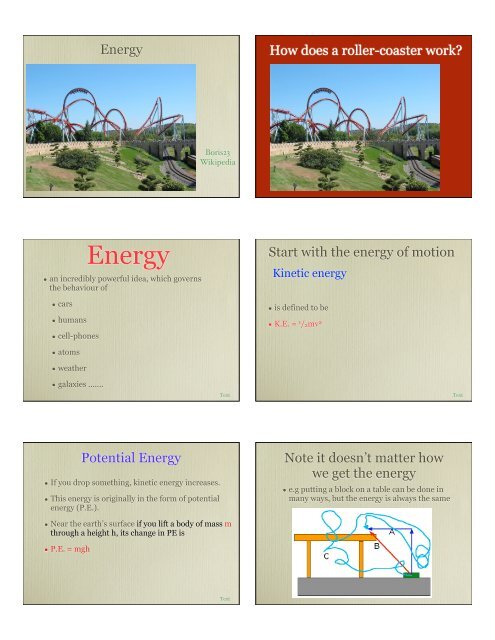


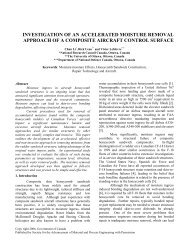
![Assignment 3 [pdf] - Department of Physics - Carleton University](https://img.yumpu.com/19038221/1/190x245/assignment-3-pdf-department-of-physics-carleton-university.jpg?quality=85)
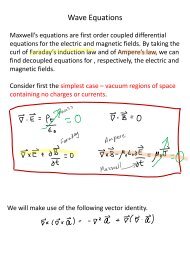
![Assignment 2 [pdf] - Department of Physics - Carleton University](https://img.yumpu.com/19038215/1/190x245/assignment-2-pdf-department-of-physics-carleton-university.jpg?quality=85)


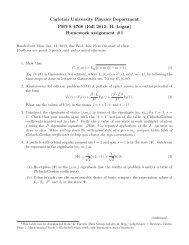

![Assignment 7 [pdf] - Department of Physics - Carleton University](https://img.yumpu.com/19038096/1/190x245/assignment-7-pdf-department-of-physics-carleton-university.jpg?quality=85)
